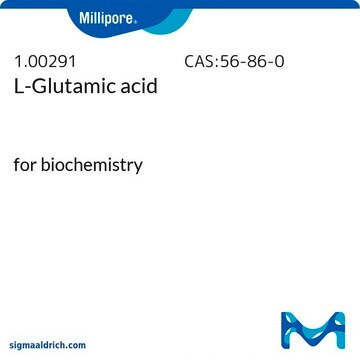W328502
L-Glutamic acid
FCC
Synonym(s):
(S)-2-Aminopentanedioic acid, Glu
Sign Into View Organizational & Contract Pricing
Select a Size
All Photos(1)
Select a Size
Change View
About This Item
Linear Formula:
HO2CCH2CH2CH(NH2)CO2H
CAS Number:
Molecular Weight:
147.13
FEMA Number:
3285
Beilstein/REAXYS Number:
1723801
EC Number:
MDL number:
UNSPSC Code:
12164502
eCl@ss:
32160406
PubChem Substance ID:
NACRES:
NA.21
organoleptic:
baked
grade:
Kosher
biological source:
corn
food allergen:
no known allergens
Recommended Products
biological source
corn
Quality Level
grade
Kosher
reg. compliance
FCC
FDA 21 CFR 172.320
FDA 21 CFR 182.1045
assay
98.5-101.5% dry basis (perchloric acid titration)
form
powder or crystals
optical activity
[α]20/D +32°, c = 10 in 2 M HCl
mp
205 °C (dec.) (lit.)
solubility
water: soluble 8.64 g/L at 25 °C
density
1.54 g/cm3 at 20 °C
Looking for similar products? Visit Product Comparison Guide
General description
L-Glutamic acid is an amino acid mainly used as a flavor enhancer in the food industry. It occurs naturally in kelp. L-Glutamic acid is said to impart umami-like taste in ready-to-drink (RTD) green tea.
Biochem/physiol Actions
An excitatory amino acid neurotransmitter that is an agonist at all subtypes of glutamate receptors (metabotropic, kainate, NMDA, and AMPA).
Disclaimer
For R&D or non-EU Food use. Not for retail sale.
Storage Class
11 - Combustible Solids
wgk_germany
WGK 1
flash_point_f
Not applicable
flash_point_c
Not applicable
ppe
Eyeshields, Gloves, type N95 (US)
Choose from one of the most recent versions:
Already Own This Product?
Find documentation for the products that you have recently purchased in the Document Library.
Customers Also Viewed
Mechanistic studies on the formation of pyrazines by Maillard reaction between L-ascorbic acid and L-glutamic acid.
Yu AN, et al.
LWT--Food Science and Technology, 50(1), 64-71 (2013)
Luigi F Agnati et al.
Pharmacological reviews, 55(3), 509-550 (2003-07-19)
The molecular basis for the known intramembrane receptor/receptor interactions among G protein-coupled receptors was postulated to be heteromerization based on receptor subtype-specific interactions between different types of receptor homomers. The discovery of GABAB heterodimers started this field rapidly followed by
Kimberly J Dougherty et al.
Neuron, 80(4), 920-933 (2013-11-26)
Locomotion is controlled by spinal networks that generate rhythm and coordinate left-right and flexor-extensor patterning. Defined populations of spinal interneurons have been linked to patterning circuits; however, neurons comprising the rhythm-generating kernel have remained elusive. Here, we identify an ipsilaterally
Nils Muhlert et al.
Journal of neurology, neurosurgery, and psychiatry, 85(8), 833-839 (2014-01-17)
Glutamate is the principal excitatory neurotransmitter and is involved in normal brain function. Cognitive impairment is common in multiple sclerosis (MS), and understanding its mechanisms is crucial for developing effective treatments. We used structural and metabolic brain imaging to test
Ulrike Pannasch et al.
Nature neuroscience, 17(4), 549-558 (2014-03-04)
Astrocytes play active roles in brain physiology by dynamic interactions with neurons. Connexin 30, one of the two main astroglial gap-junction subunits, is thought to be involved in behavioral and basic cognitive processes. However, the underlying cellular and molecular mechanisms
Chromatograms
application for HPLCOur team of scientists has experience in all areas of research including Life Science, Material Science, Chemical Synthesis, Chromatography, Analytical and many others.
Contact Technical Service





